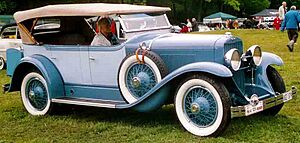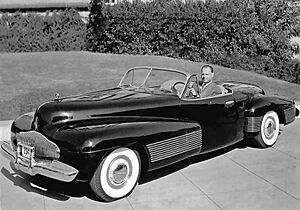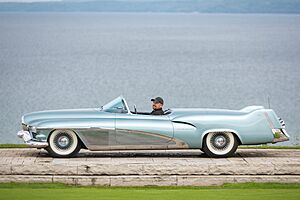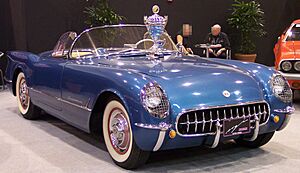Harley Earl facts for kids
Quick facts for kids
Harley J. Earl
|
|
|---|---|
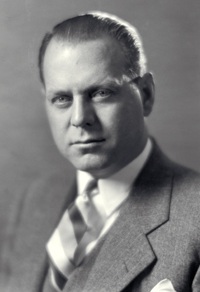 |
|
| Born |
Harley Jarvis Earl
November 22, 1893 Hollywood, California, United States
|
| Died | April 10, 1969 (aged 75) West Palm Beach, Florida, United States
|
| Occupation | Car designer and executive |
| Known for | First head of design at General Motors Innovations in automotive design |
Harley Jarvis Earl (born November 22, 1893 – died April 10, 1969) was an American car designer and business leader. He was the very first head of design at General Motors (GM), a huge car company. He even became a vice president, which was a big deal for someone in design! Harley Earl was a pioneer in designing cars and other vehicles.
He started out building custom car bodies. He was the first to use freehand drawings and clay models to design cars. He also created the "concept car". This was a special car built to show new design ideas and to get people excited about future cars.
Harley Earl designed the Buick Y-Job, which was the first-ever concept car. He also started "Project Opel," which later became the famous Chevrolet Corvette. He was also the one who brought the idea of tailfins to car styling. During World War II, he helped with research to make camouflage better for the Allies.
Contents
Early Life and Car Design Beginnings
Harley Jarvis Earl was born in Hollywood, California. His father, J.W. Earl, started a business in 1889 building custom bodies for horse-drawn vehicles. Later, his father's company, Earl Automobile Works (started in 1908), began making custom car bodies and parts.
Harley Earl went to Stanford University, but he left early. He wanted to work with his father and learn from him at Earl Automotive Works. By this time, their shop was building special custom cars for famous Hollywood movie stars. These stars included Roscoe "Fatty" Arbuckle and Tom Mix.
Harley Earl at General Motors
A Cadillac car dealer named Don Lee bought Earl Automotive Works. He kept Harley Earl as the director of the custom car shop.
Lawrence P. Fisher, who was in charge of Cadillac, visited Don Lee's dealership. Fisher was very impressed with Harley Earl's designs and how he worked. He especially liked that Earl used modeling clay to create the shapes of his car designs.
Fisher asked Earl to design the 1927 LaSalle car for Cadillac. The LaSalle was a big success! This convinced Alfred P. Sloan, the president of General Motors, to create a new department. It was called the "Art and Color Section," and Harley Earl became its first director in 1927.
Before this, car companies in America didn't think much about how cars looked. Engineers usually designed the car bodies, focusing only on how they worked and how much they cost. Many luxury car makers didn't even build the bodies themselves. They would send the car parts to a special builder chosen by the buyer.
At first, some people at General Motors, especially the engineers, thought Earl's ideas were too fancy. They called him one of the "pretty picture boys" and his design studio the "Beauty Parlor."
In 1937, the "Art and Color Section" was renamed the Styling Section. Alfred P. Sloan later made Earl a vice president. This made him the first design person to become a vice president at a large company. After the early 1930s, Earl didn't draw much himself. He mostly supervised other designers, but he always had the final say on all designs until he retired in 1958.
Harley Earl and Sloan also started the idea of the "Annual Model Change." This meant that car models would change slightly each year. This made design a key reason for people to buy new cars. Earl was careful not to change the style too much each year. This helped keep the value of used GM cars high. He also avoided extreme designs that might quickly look old. These ideas are common today, but they were new back then.
The Buick Y-Job: First Concept Car
In 1939, Harley Earl's Styling Division designed and built the Buick Y-Job. This was the very first concept car in the car industry. Many unique custom cars had been made before. But the Y-Job was the first car built by a big car company just to see how people would react to new design ideas. After being shown to the public, the Y-Job became Harley Earl's own car that he drove every day. Later, the 1951 General Motors Le Sabre concept car followed it.
Camouflage Research During World War II
In 1942, during World War II, Earl created a special division at General Motors. This division focused on researching and training people in camouflage. One result was a 22-page book called Camouflage Manual for General Motors Camouflage.
The Rise of Tailfins
Harley Earl approved the design for the 1948 Cadillac, which was the first car to have an automotive tailfin. Many new cars in 1948-49 had a "bathtub" or fastback style. Earl thought about this for Cadillac but decided against it. Instead, he chose a sleek, aircraft-inspired look. This was a smart choice, as the "bathtub" style quickly looked old. The 1948 Cadillac's design was more forward-thinking and helped GM stay ahead in car design.
The idea for the tailfins came from the Lockheed P-38 Lightning airplane. This style became very popular in the 1950s and 1960s, especially as space rockets captured people's imaginations. Car companies like General Motors and Chrysler competed to make the biggest and most complex tailfins. The tailfins on the 1959 Cadillac models were some of the largest.
Creating the Chevrolet Corvette
After World War II, Harley Earl saw many cool English and European sports cars being raced. He decided that General Motors needed to make its own sports car. The design work for this secret project, called "Project Opel," began. He offered the project to Ed Cole, the general manager of Chevrolet. Cole quickly accepted, and the car was introduced to the public in 1953 as the Chevrolet Corvette.
Retirement and Legacy
Harley Earl retired in 1958 when he turned 65. His last project was overseeing the design of the 1960–62 car models. Bill Mitchell took over his role as vice president of the Design and Styling Department.
Before Earl retired, General Motors became the biggest company in the world. Car design was recognized as a main reason why people bought cars.
Death and Lasting Impact
Harley Earl passed away in West Palm Beach, Florida, on April 10, 1969, at the age of 75.
He is remembered as the first head of car styling in the United States. He also started using clay modeling for car designs. He introduced the wraparound windshield, the hardtop sedan, two-tone paint from the factory, and tailfins. In 1954, he said his main goal for 28 years was "to lengthen and lower the American automobile." The very long and low American cars of the 1960s and 1970s show how much Earl influenced the entire car industry and culture.
He was added to the Automotive Hall of Fame in 1986.
One of his concept car designs, the turbine-powered Firebird I, is shown in miniature on the Harley J. Earl Trophy. This trophy is given to the winner of the Daytona 500 NASCAR race each year.
Harley Earl was even featured in some Buick advertisements in the early 2000s. An actor playing Earl (or his ghost) was used to show how important design was to Buick's cars.
In a special section of the Detroit Free Press in 1999, Earl was ranked the third most important Michigan artist of the 20th century. He was behind only Aretha Franklin and Stevie Wonder.
See also
 In Spanish: Harley Earl para niños
In Spanish: Harley Earl para niños
- NASCAR National Commissioner
- Eugene Turenne Gregorie
- 1950s American automobile culture


